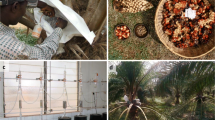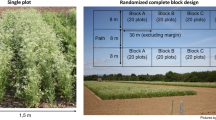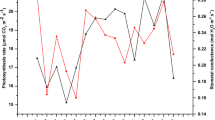Summary
Phenotypic recurrent selection was carried out for oil content in East Indian lemongrass, Cymbopogon flexuosus (Steud) Wats. In each cycle, the top 5% of plants for oil content were selected. Their ramets were used for the establishment of replicated polycross blocks in isolation. Realized gains from selection were determined by evaluating the populations and the best clones from each population in separate two-year replicated trials. Three cycles of recurrent selection increased oil content by 32% per cycle at the population level. Realized gains from selection were slightly smaller or similar to predicted gains. Mean realized heritability for oil content was 0.56. At the clonal level, the best C1 and the best C2 clones had, respectively, a 22% and 73% higher oil content than the best clone from the base population (C0). Selection for oil content did not adversely affect leaf yield, dry matter content or citral content in oil. Probable reasons for the high response to selection are mentioned.
Similar content being viewed by others
References
Falconer D.S., 1981. Introduction to Quantitative Genetics. 2nd Ed., Longman, London, pp. 340.
Kulkarni R.N. & K.Rajagopal, 1986. Broad and narrow sense heritability estimates of leaf yield, leaf width, tiller number and oil content in East Indian lemongrass. Z. Pflanzenzüchtg. 96: 135–139.
Kulkarni R.N. & S.Ramesh, 1987. Heritability estimates of citral content in East Indian lemongrass. Theor. Appl. Genet. 73: 476–477.
Kulkarni R.N. & S.Ramesh, 1992. Development of lemongrass clones with high oil content through population improvement. J. Ess. Oil Res. 4: 181–186.
Kulkarni R.N., K.Rajagopal & S.Ramesh, 1986. Selection for oil content in East Indian lemongrass. Plant Breeding 97: 78–81.
Lawerence B.M., 1985. A review of the world production of essential oils (1984). Perfumer & Flavorist 10 (5): 1–16.
Little T.M. & F.J.Hills, 1978. Agricultural Experimentation. Design and Analysis. John Wiley, New York, pp. 350.
Rao B.L. & S.N.Sobti, 1991. Ckp-25, a hybrid lemongrass. Indian Perfumer 35: 148–149.
Sharma J.R., R.K.Lal, H.O.Misra & A.A.Naqui, 1987. A genetically improved clone-CIMAP/LS 48 (var. Pragati) of lemongrass developed. Pafai J. 9: 17–19.
Sharma J.R., H.O.Misra & R.K.Lal, 1989. An improved variety Praman of Cymbopogon pendulus developed. A potential source of citral. Pafai J. 11: 13–19.
Vogel K.P., H.J.Gorz & F.A.Haskins, 1981. Heritability estimates for forage yield, in vitro dry matter digestibility, crude protein and heading date in Indian grass. Crop Sci. 21: 35–38.
Author information
Authors and Affiliations
Rights and permissions
About this article
Cite this article
Kulkarni, R.N. Phenotypic recurrent selection for oil content in East Indian lemongrass. Euphytica 78, 103–107 (1994). https://doi.org/10.1007/BF00021404
Received:
Accepted:
Issue Date:
DOI: https://doi.org/10.1007/BF00021404




